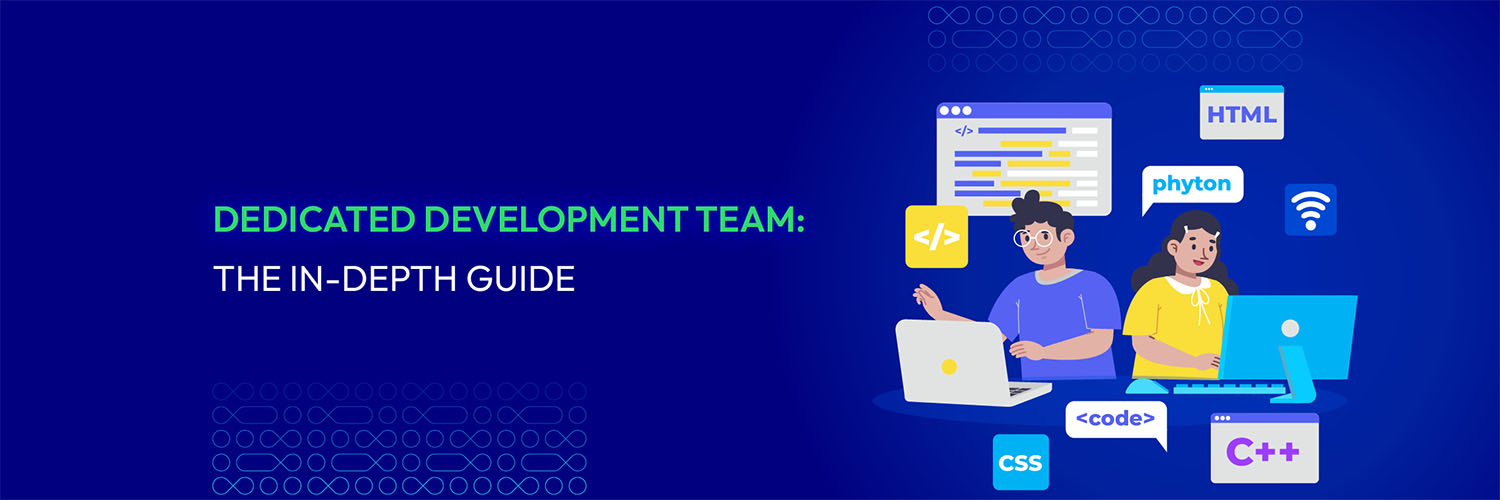Dedicated Development Team: When and How to Hire?
Vinh Jacker | 07-31-2023

In today’s technological landscape, businesses face the challenge of delivering high-quality software solutions efficiently and effectively. This has led to the rise of Dedicated Development Teams as a popular approach to handling complex projects.
But what exactly is a Dedicated Development Team? When is it the right choice for your organization? In this blog, we will demystify the concept of Development Teams and shed light on their pros, cons, and use cases.
Whether you are a tech enthusiast, a project manager, or a business owner, understanding this development model can greatly impact your software endeavors. Let’s dive in and unlock the potential of this innovative approach together!
Who is Included in the Dedicated Development Team?
The specific composition of a dedicated team may vary depending on the project requirements and needs. Therefore, your dedicated development team could include the following:
| Role | Description |
|---|---|
| Developers | Write code and implement software solutions (front-end, back-end, full-stack, mobile app, or specialists) |
| Project Manager | Oversees development process, manages deadlines, aligns with client objectives, coordinates with stakeholders, facilitates communication, and manages resources. |
| UX/UI Designers | Create user interfaces and user experiences (visually appealing, intuitive, and aligned with the brand), collaborates with developers for seamless design integration. |
| Quality Assurance (QA) Engineers | Test and ensure product quality, create test plans, execute test cases, identify and report bugs, and work with developers to fix issues. |
| DevOps Engineers | Streamline development process through CI/CD pipelines, automate processes, manage infrastructure, and optimize software delivery workflow. |
| Business Analysts | Bridge the gap between the client's business needs and the development team, gather and analyze specifications, identify user needs, define requirements, and create a project roadmap. |
Why Should You Hire Dedicated Development Team?
Hiring a dedicated development team offers substantial advantages for businesses aiming to enhance efficiency and quality in their projects.
-
Cost savings: Companies can save 25% on operational cost by using offshore dedicated development team compared to in-house teams, as reported by Deloitte . This model eliminates expenses related to office space, equipment, and full-time employee benefits.
-
Access to top talent: Building an in-house team requires significant time and resources for recruitment. By outsourcing, you gain access to a global talent pool, leveraging a wider range of expertise.
-
Focus on core business activities: By outsourcing development tasks to a dedicated team, companies can focus more on their core business activities. A study by Clutch indicates that 37% of companies outsource to improve business focus . This allows internal teams to concentrate on strategic initiatives rather than being bogged down by technical development tasks.
-
Speed to market: Dedicated teams often accelerate the development process due to their expertise and streamlined workflows. Faster time to market is critical in maintaining a competitive edge. According to a McKinsey report , companies that can develop software quickly and efficiently are more likely to gain a first-mover advantage and capture a significant market share .

How Much Does It Cost to Hire Dedicated Development Team?
The cost of hiring a dedicated development team can vary depending on several factors, including:
-
Location: Developers in North America and Western Europe typically command the highest hourly rates, often ranging from $100 to $200 per hour. Rates can be significantly lower in other regions, like Eastern Europe ($35-55 per hour) or Asia ($15-40 per hour).
-
Team composition: The specific roles you need on your team (e.g., front-end developers, back-end developers, QA testers) will affect the overall cost. Senior developers with more experience will also cost more than junior developers.
-
Project complexity: Complex projects requiring specialized skills or cutting-edge technologies will likely cost more than simpler projects.
Overall, here’s a rough estimate of the cost to consider:
- Hourly rates: $50 to $200 per hour per developer
- Monthly cost per developer: $10,000 to $20,000+ per month (for mid to senior level)
How to Hire Dedicated Development Team?
This guide explores hiring a dedicated development team, a cost-effective and efficient way to bolster your development muscle.
Step 1. Defining your requirements
Underestimating the complexity of your project can lead to timeline delays and budget overruns. Thus, be thorough in defining your requirements to avoid surprises later.
Clearly define your project’s requirements. This includes:
-
Project scope: What are you building? Define core functionalities, desired features, and future considerations. Don’t be afraid to start with a Minimum Viable Product (MVP) and iterate based on user feedback.
-
Technology stack: Do you have specific programming languages or frameworks in mind? While flexibility is good, a base understanding helps target teams with the right skillset.
-
Team structure: What kind of expertise do you need? Consider developers, designers, project managers, and QA testers.

Step 2. Finding the right development partner
With your requirements defined, it’s time to explore potential partners. Here are some key places to find dedicated development team:
-
Software development outsourcing companies: These companies specialize in providing development teams for hire. They have a pool of pre-vetted developers and can quickly assemble a team that meets your specific needs. Mageplaza is one of the best choices. We provide access to a pool of vetted developers with expertise across various technologies (Magento, Shopify, Laravel, PHP, Python, etc) . Want to benefit from a seamless onboarding process, transparent communication, and cost-effective solutions, contact Mageplaza now !
-
Freelance platforms: Platforms like Upwork and Fiverr allow you to browse profiles of freelance developers and assemble your own team. However, this approach can be more time-consuming and requires more effort to ensure the quality of the developers you hire.
-
Staff augmentation agencies: These agencies specialize in helping companies find temporary or contract staff, including developers. They can help you find qualified developers who are available to work on your project on a short-term basis.
Common Mistake: Employers often make the mistake of focusing solely on cost. While budget is important, choosing the cheapest option can lead to poor quality work and delays.You need to schedule initial calls to assess their understanding of your project and their ability to adapt to your needs.
Step 3: Separating the good from the great
Not all development partners are created equal. Falling for empty promises or overlooking crucial aspects can lead to project failure.
Here’s how to effectively vet potential partners:
-
In-depth interviews: Go beyond technical expertise. Discuss their experience with similar projects, their development methodology (e.g., Agile, Waterfall), and communication style.
-
Portfolio review: Ask to see examples of their past work that align with your project’s needs.
-
Client references: Reach out to past clients and get honest feedback about their experience.
-
Technical assessment: If relevant, consider a technical assessment to gauge the team’s capabilities.
Step 4: Negotiating the engagement model and rates
Negotiating rates and contracts can be tricky. Employers might get stuck with unfavorable terms or hidden costs.
Here’s how to approach negotiations effectively:
-
Engagement model: Choose a model that suits your project. Fixed-cost models offer predictability, while time and material (T&M) models provide more flexibility. Rate Structure: Be clear on hourly rates or project milestones. Consider factors like team experience and location when evaluating costs.
-
Contract clarity: Ensure the contract clearly outlines deliverables, timelines, payment schedules, and intellectual property (IP) ownership.
-
Communication channels: Define clear communication protocols for project updates, issue escalation, and feedback exchange.
Remember: Negotiation is a two-way street. Aim for a win-win situation that fosters a long-term, successful partnership.
Step 4: Transfer knowledge from the in-house team to the Dedicated Development Team
To provide a dedicated development team with valuable insights into your company’s processes, you need to develop a comprehensive knowledge transfer process.
You may want to create step-by-step instructions and examples to comprehensively understand how tasks are performed. This documentation helps Development Team members align their work with your established processes.
To avoid culture clash, which is a common issue with a dedicated development team, communicate your company’s culture, mission, and values. Share information about the work environment, teamwork dynamics and communication norms.

Step 5: Dedicated development team onboarding
Before starting the collaboration, create a definite understanding of the range of work, project prerequisites, and expected results. This includes outlining precise checkpoints, project schedules, and results.
You should work collaboratively with the development team provider to establish a mutual understanding and expectations. Providing them with relevant background information regarding the project’s objectives, intended audience, and expected outcomes is a good starting point.
You may also want to give the team access to the company’s infrastructure, tools, and software. Additionally, by providing them insights into your in-house team’s approaches and workflows, you will collaborate with them more effectively.
Step 6: Establish a strong communication plan
Establishing a strong communication plan is imperative to staying connected with the team. You may want to consider arranging a kick-off meeting with the team members to delve into the project’s specifics, including its scope, requirements, and milestones. This meeting should foster in-depth discussions to address any queries or uncertainties and ensure everyone is on the same page regarding the project’s objectives.
Additionally, the kick-off meeting helps establish transparent communication channels and foster a collaborative partnership between the Development Team and your in-house team.
Dedicated Development Team Vs Other Models: The Comparison
Here, we’ll compare dedicated Development Teams to two popular alternatives: Time & Material and Fixed Price models:
| Feature | Dedicated Team | Time and Material | Fixed Price |
|---|---|---|---|
| Focus | Exclusive team for your project | Billed for time spent | Fixed upfront cost for entire project |
| Cost | Hourly rates or retainers | Transparent; pay for work done | Fixed upfront cost |
| Flexibility | High; ideal for evolving requirements | High; ideal for short-term or undefined scopes | Low; major changes require renegotiation |
| Management | More control over development and team | Requires high involvement in oversight and scope | Requires clear upfront scope to mitigate risks |
| Best for | Complex projects, evolving requirements, long-term partnerships | Well-defined, short-term projects, limited budget | Well-defined, fixed scope, budget priority |
| Risk | Lower for client (unexpected changes managed within reason) | Higher for development company (changes or complexities) | Lower for client; fixed cost |
Dedicated Team Vs. Time & Material model
The Time & Material model is another format that frequently competes with the Dedicated Development Team. With the former model, the client pays for the team’s real-time effort spent on a feature.
The Time & Material model is appropriate for the following:
-
Projects with evolving requirements
-
Markets that have not been explored
-
Product market fit that has yet to be identified
In terms of cost, in the Time & Material model, the client pays for the actual hours worked by the development team and any additional costs incurred, such as software licenses or third-party services. The rates are typically based on an hourly or daily basis.
Time & Material engagements are often used for shorter projects or specific development tasks where the scope can be clearly defined. It allows the client to engage the development team for a limited time.
Dedicated Development Team Vs. Fixed Price Model
Another format of engaging with software development teams is the fixed-price model. There is often confusion between this model and a Dedicated Development Team model. Nevertheless, these two forms cater to vastly different commercial requirements.
A fixed price model will be most suitable for:
-
Projects with a limited timeframe
-
Short-term projects
-
Detailed specifications
-
MVP development
-
Projects with less evolving project requirements
In the fixed price model, the client and the development team agree upon a fixed price for a defined scope of work. The cost is determined based on the project’s requirements, deliverables, and planned timeline.
One pitfall of the fixed price model is the risk of overpayment since it is not always possible to predict the time and scope of labor. Even if the job is not completed, you will be required to pay the agreed-upon fee. Meanwhile, when hiring a dedicated development team, the client often pays a fixed monthly charge that includes the team’s salaries, project management, and overhead costs.
Conclusion
To sum up, a dedicated team is an ideal choice for projects with unclear requirements, such as aspiring startups and growing tech businesses. These enterprises, which value long-term collaboration, benefit greatly from the dedicated partnership model.
A Dedicated Development Team will offer several advantages of cost optimization and access to a team of selected professionals. Considering all of this, it’s up to you to determine if hiring a development team is the right decision for your specific needs.





![Top 20+ Must-have Shopify Apps for 2025 [Free & Paid] - Mageplaza](https://cdn2.mageplaza.com/media/blog/must-have-shopify-apps/top-must-have-shopify-apps.png)
![[2025 Updates] Top 10+ Upsell Apps for Shopify - Mageplaza](https://cdn2.mageplaza.com/media/blog/best-upsell-shopify-app/cover.png)